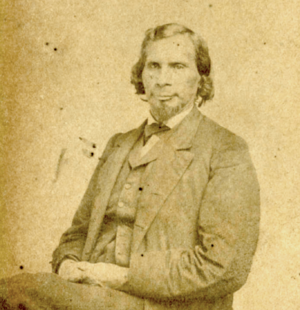Maris Bryant Pierce facts for kids
Quick facts for kids
Maris Bryant Pierce
|
|
|---|---|
 |
|
| Born | 1811 |
| Died | August 9, 1874 |
| Nationality | Seneca Nation, United States |
| Other names | M. B. Pierce, Swift Runner, Ha-dya-no-doh |
| Alma mater | Dartmouth College |
| Occupation | Tribal chief, lawyer, teacher, interpreter, activist |
Maris Bryant Pierce (1811–1874), also known by his Seneca names Ha-dya-no-doh or Swift Runner, was an important leader of the Seneca Nation. He was a chief, a lawyer, and a teacher. He worked hard to protect his tribe's land rights and played a big part in the discussions around the Second Treaty of Buffalo Creek in 1838.
Contents
Early Life and Education
Maris Bryant Pierce was born in 1811 on the Allegany Indian Reservation in New York. As a young person, he went to several schools, including the Quaker school Fredonia Academy and other boarding schools in New York and Vermont.
When he was a teenager, Maris Bryant Pierce became a Christian and joined the Presbyterian church. Even after this, he still kept his traditional Seneca beliefs about nature. From 1836 to 1840, he attended Moor's Indian Charity School, which later became Dartmouth College. After finishing college in 1840, he moved to the Buffalo Creek Reservation.
Fighting for Land Rights
While Maris Bryant Pierce was in college, he became a "young chief" for the Seneca Nation. This meant he was a rising leader who helped make important decisions for his people. Another young Seneca chief at this time was Nathaniel Thayer Strong. Strong worked as an interpreter during the Second Treaty of Buffalo Creek, but he supported the idea of moving the Seneca people.
The Treaty of Buffalo Creek
The Second Treaty of Buffalo Creek in 1838 was a very important agreement. It proposed that the Seneca Nation sell their lands in New York state to a company called the Ogden Land Company. The treaty also suggested that the Seneca tribe move far away to a place called Indian Territory, which is now in Oklahoma.
Maris Bryant Pierce was chosen to be the lawyer for the Seneca people living on the Tonawanda Reservation, Allegany Reservation, Cattaraugus Reservation, and Buffalo Creek Reservation. He strongly believed the Seneca people should not have to move. On August 28, 1838, he gave a famous speech in Buffalo, New York. In his speech, called Address on the Present Condition and Prospects of Aboriginal Inhabitants of North America, with Particular Reference to the Seneca Nation, he spoke out against the land removal. Fourteen other Seneca chiefs supported Pierce in his fight against the treaty.
Continuing the Fight
Even after the United States Senate approved the Second Treaty of Buffalo Creek in 1840, Pierce kept fighting. He wrote many articles and letters to argue against the removal. He was in a difficult position, trying to work between Seneca traditions and the ideas of the American government. He used ideas about "European enlightenment" to help explain why the Seneca people should keep their land.
The fight over the treaty lasted for many years, even after Pierce's death. It was finally settled in 1898. The United States government paid a large amount of money, nearly $2 million, to the "New York Indians" as payment for the land.
Later in his life, Maris Bryant Pierce worked as a language interpreter for the Seneca Nation. He also helped the Seneca Nation create a new way of governing themselves, where leaders were chosen by votes.
Death and Legacy
Maris Bryant Pierce passed away on August 9, 1874, at the Cattaraugus Reservation. His important work and writings are kept in special collections. You can find them at the Dartmouth Library and Archive, the Buffalo Historical Society (which is now the Buffalo History Museum), and in the Smithsonian Online Virtual Archives. His efforts helped protect the rights and lands of the Seneca people for future generations.
See also

